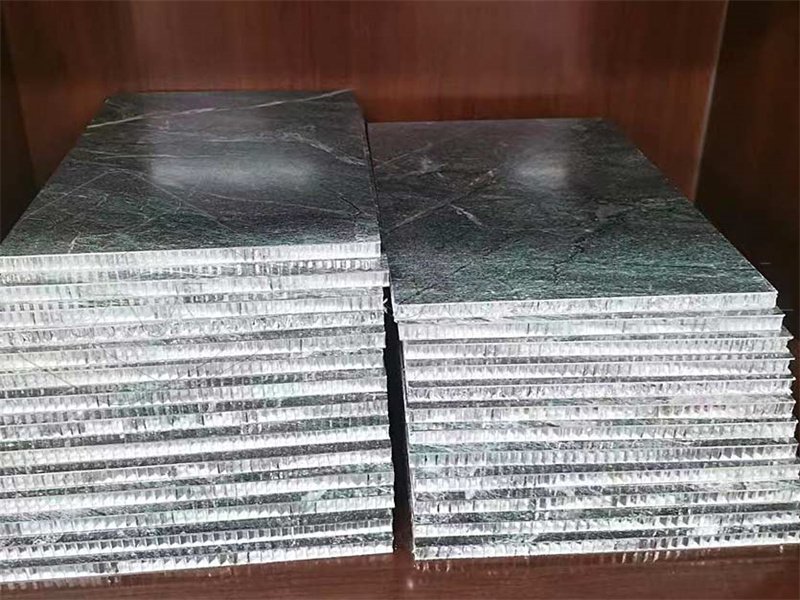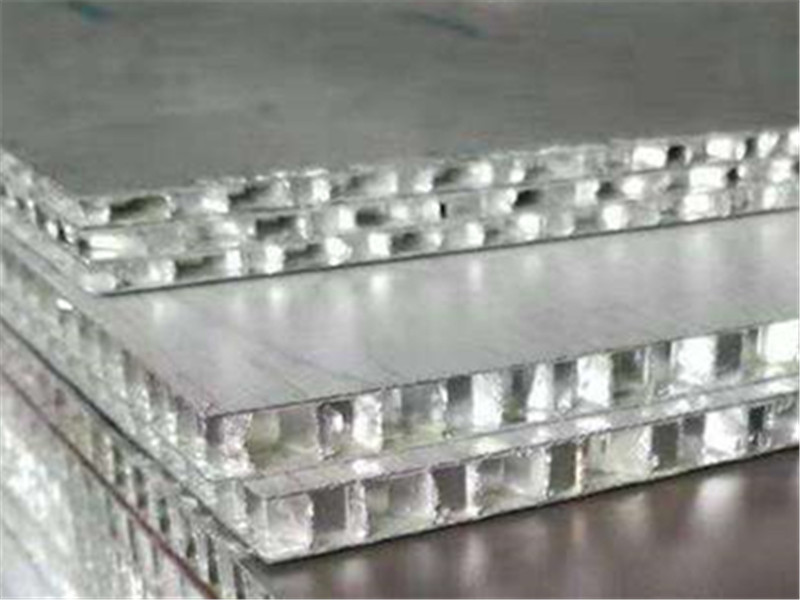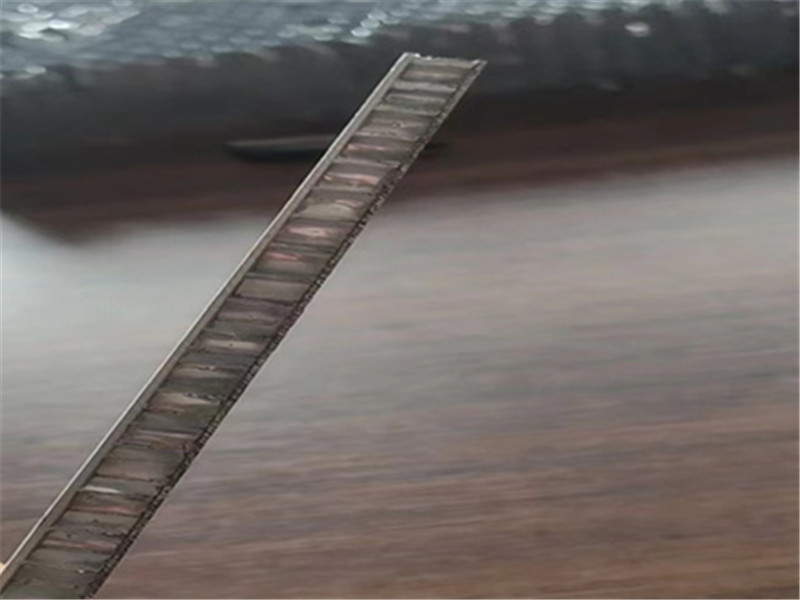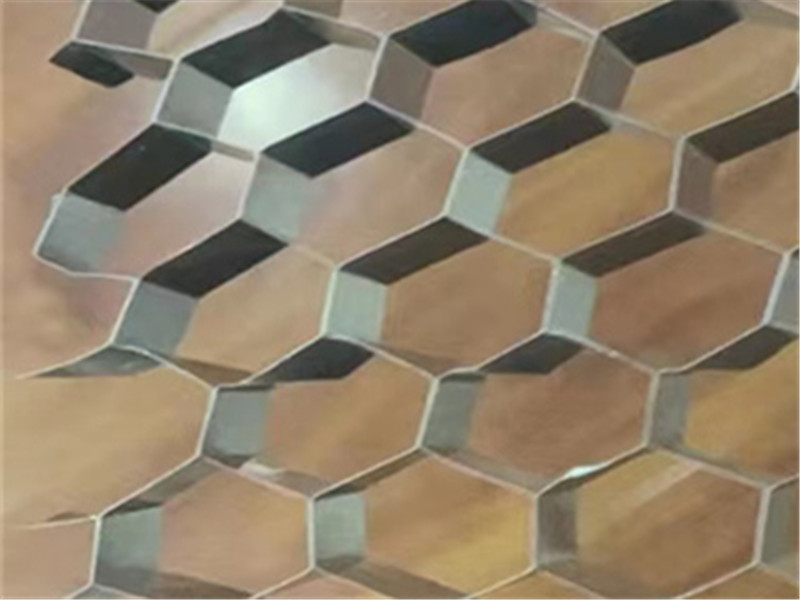Aluminum honeycomb panel is a sandwich panel with a honeycomb structure as its core, which is inspired by the natural hexagonal honeycomb. It’s the application of aviation and aerospace materials in the field of civil construction. Therefore, we generally use it in ceilings, coach body, clean room systems, commercial facades, etc.

Common Types and Specifications of Aluminum Honeycomb Panels
Aluminum Honeycomb Panels come in various types, primarily defined by their surface finish, thickness, and core specifications. The choice depends on the specific application and desired aesthetics.
| Specification Feature | Common Values/Examples | Description & Impact |
|---|---|---|
| Panel Thickness | 6mm, 10mm, 15mm, 20mm, 25mm, 30mm, 50mm | Overall thickness of the honeycomb panel. Thicker panels generally offer greater rigidity and insulation but are heavier and cost more. |
| Face Skin Thickness | 0.5mm, 0.8mm, 1.0mm, 1.2mm | Thickness of the top and bottom aluminum sheets. Thicker skins provide more strength and better impact resistance. |
| Aluminum Alloy (Skins) | 3003, 5052 | Common aluminum alloys. 3003 is standard; 5052 offers higher strength and better corrosion resistance, often used in marine applications. |
| Core Cell Size | 4mm, 6mm, 8mm, 10mm, 12mm | The size of the hexagonal cells in the core. Smaller cell sizes generally lead to a denser, stronger core, especially for thinner panels. |
| Surface Finish | PVDF Coated, PE Coated, Anodized, Brushed, Wood Grain, Stone Grain | PVDF (Polyvinylidene Fluoride) is a premium coating offering excellent weather resistance and color stability, ideal for outdoor use. PE (Polyester) is more economical for interior use. Anodized provides a durable, natural metal look. |
| Standard Widths | 1220mm, 1250mm, 1500mm | Common manufacturing widths for the aluminum panel. Custom widths are possible but may incur extra costs. |
| Standard Lengths | 2440mm, 3000mm, 5800mm, Custom (up to 10m+) | Panels can be very long to reduce joints on large surfaces. |
| Fire Rating | A2, B1 (per EN 13501-1) | Classification of fire behavior. A2 is non-combustible, B1 is highly flame retardant. Crucial for building safety. |
| Density (approx.) | 3 – 15 kg/m² | The weight per square meter of the panel. Varies significantly with thickness and skin gauge. Demonstrates the lightweight panel advantage. |

Structure of Aluminum Honeycomb Panel
Panel: Aluminum honeycomb panel is mainly takes alloy aluminum plate as the base material. The panel thickness is 0.8~1.5mm fluorocarbon roll coating plate or color resistant light baking paint. Color resistant light baking paint is stronger than PVDF in terms of scratch resistance, acid rain corrosion resistance and discoloration, and self-cleaning properties.
Core: Core material is hexagonal 3003 type and 5052 type aluminum honeycomb core. the thickness of aluminum foil is 0.04~0.06mm.


Advantage of Aluminum Honeycomb Plate
Fire retardant
Light weight and high strength
Superior flatness, and exceptional stiffness
Sound insulation
Easy installation and maintenance
Fully recyclable
Aluminum Honeycomb Panel Material
The materials for producing aluminum honeycomb panels are composite decorative panels, back panels, aluminum panels, node glue and honeycomb cores. Surface treatment include electrostatic spraying, polyester spraying, fluorocarbon paint, imitation wood grain, imitation stone grain, anodizing, etc. These surface treatment can enhance the service life of aluminum honeycomb sandwich panel. Aluminum honeycomb panel composite decorative panel is generally made of high-quality aluminum alloy sheet. Generally, fluorocarbon baking paint is suitable for building exterior wall decoration.
Hot Tags
Aluminum honeycomb sheet, aluminum honeycomb plate, aluminum honeycomb sandwich panel, aluminum honeycomb core
Discovering the Versatile Aluminum Honeycomb Panel
In today’s world of advanced building and design, engineers and architects are always looking for materials that are both strong and light. One such amazing material is the Aluminum Honeycomb Panel. If you’ve ever wondered about those sleek, modern building facades or incredibly strong yet lightweight structures in planes, there’s a good chance an Aluminum Honeycomb Panel is at their core.
So, what exactly is an Aluminum Honeycomb Panel? It’s a type of “sandwich panel” or “composite panel” made by bonding two thin sheets of aluminum (called “skins”) to a thicker core material that looks like a honeycomb. This unique design gives the panel incredible strength while keeping it very light. It’s truly a marvel of modern material engineering.
The Anatomy of an Aluminum Honeycomb Panel
To understand why this composite panel is so special, let’s break down its parts:
- Face Skins (Top and Bottom): These are usually thin sheets of high-strength aluminum alloy. They provide the panel’s surface and protect the core. The type of aluminum used here affects the panel’s durability and finish.
- Honeycomb Core: This is the heart of the Aluminum Honeycomb Panel. It’s made from thin aluminum foils joined together to form a series of hexagonal (six-sided) cells, much like a natural beehive. This structure is key to the panel’s strength and lightweight properties.
- Adhesive: A special, strong adhesive is used to bond the aluminum skins to the honeycomb core. This bond must be very strong to ensure the panel acts as a single, unified unit.
When these three parts are pressed and bonded together under heat and pressure, they form a single, rigid structural panel that is much stronger and lighter than a solid sheet of aluminum of the same thickness.
Why “Honeycomb”? The Benefits of the Unique Core
The hexagonal cell structure of the core is what makes the Aluminum Honeycomb Panel so effective. Here’s why this design is so clever:
- Exceptional Strength-to-Weight Ratio: The honeycomb design distributes stress evenly across the panel. This means it can resist bending and buckling far better than a solid material of the same weight. It makes the panel incredibly strong while remaining remarkably lightweight.
- Excellent Flatness: The honeycomb core provides continuous support to the face skins, preventing warping or buckling, even over large areas. This results in panels with outstanding flatness, crucial for aesthetic applications.
- Rigidity: The open cell structure creates a highly rigid panel. This rigidity helps maintain its shape and prevents deformation under load.
- Energy Absorption: The honeycomb cells can absorb energy, making the panel resistant to impact.
- Thermal and Sound Insulation: The trapped air within the honeycomb cells acts as an insulator, offering good thermal and sound-damping properties. This can contribute to energy efficiency and quieter spaces.
These benefits make the Aluminum Honeycomb Panel a top choice for demanding applications where both performance and weight savings are critical.
Key Features and Advantages of Aluminum Honeycomb Panels
Choosing an Aluminum Honeycomb Panel for your project brings a host of advantages:
- Lightweight: Significantly lighter than solid aluminum panels, reducing structural load on buildings and making installation easier.
- High Strength and Rigidity: Offers superior stiffness and resistance to deformation, making it a robust structural panel.
- Excellent Flatness: Provides a smooth, uniform surface ideal for architectural facades and interior finishes.
- Fire Resistance: Aluminum is non-combustible, and the panel often meets high fire safety standards.
- Corrosion Resistance: Aluminum naturally resists rust, and with proper coatings, it can withstand harsh environments.
- Sound Insulation: The honeycomb structure helps reduce sound transmission, improving acoustic comfort.
- Thermal Insulation: Contributes to energy efficiency by reducing heat transfer.
- Impact Resistance: The cellular core can absorb impacts effectively.
- Easy Fabrication: Can be cut, bent, and shaped to meet specific design requirements.
- Environmentally Friendly: Aluminum is recyclable, making it a sustainable choice.
Manufacturing Process
The creation of an Aluminum Honeycomb Panel involves several precise steps. First, the aluminum honeycomb core is expanded from thin aluminum foil. Then, the aluminum face skins are cleaned and prepared. Finally, the core is carefully sandwiched between the skins, and a high-strength adhesive is applied. The entire assembly is then pressed under specific heat and pressure conditions to create a strong, permanent bond, resulting in the finished aluminum honeycomb panel.
Diverse Applications of Aluminum Honeycomb Panels
The unique combination of strength, lightness, and flatness makes the Aluminum Honeycomb Panel suitable for a wide array of applications across many industries. This lightweight panel is not just for buildings; it’s used in transport, furniture, and more.
- Building Facades and Wall Cladding: A primary use for modern, lightweight, and aesthetically pleasing exteriors.
- Interior Decoration and Wall Panels: Used for sleek, flat internal walls, partitions, and ceilings in commercial and residential spaces.
- Ceilings: Provides a lightweight and visually appealing ceiling solution.
- Cleanroom Walls and Ceilings: Their flat, smooth, and easily cleanable surface makes them ideal for sterile environments.
- Elevator Panels: Used for lightweight and durable elevator car interiors.
- Marine Industry: For ship interiors, bulkheads, and even boat hulls where weight reduction is crucial.
- Railway Vehicles: Used for flooring, walls, and ceilings in trains and trams to reduce weight and improve efficiency.
- Aerospace Industry: Employed in aircraft interiors, flooring, and non-structural components due to their extreme strength-to-weight ratio.
- Furniture and Table Tops: For lightweight yet strong furniture, especially large tables.
- Display Boards and Signage: Provides a flat, rigid, and durable substrate for large-format printing and signage.
- Bus and Truck Bodies: For lightweight and strong vehicle construction.
Conclusion
The Aluminum Honeycomb Panel stands out as a remarkable material in modern construction and design. Its unique “sandwich” structure, combining thin aluminum skins with an aluminum honeycomb core, delivers an exceptional blend of lightness, strength, and flatness. From the impressive facades of skyscrapers to the intricate interiors of aircraft, this versatile composite panel offers architects, designers, and engineers a superior solution for achieving both performance and aesthetic goals. Understanding “What is Aluminum Honeycomb Panel?” reveals a material that is truly at the forefront of innovative design, offering durability, efficiency, and a sleek appearance for countless applications.
